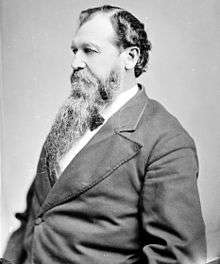Philip Cook (general)
Philip Cook (July 31, 1817 – May 21, 1894)[1] was a general in the Confederate States Army during the American Civil War and a postbellum member of the United States Congress.
Philip Cook | |
|---|---|
 Circa 1870-1880 | |
| Member of the U.S. House of Representatives from Georgia's 3rd district | |
| In office March 4, 1873 – March 3, 1883 | |
| Preceded by | John S. Bigby |
| Succeeded by | Charles F. Crisp |
| Georgia Secretary of State | |
| In office 1890–1894 | |
| Personal details | |
| Born | July 31, 1817 Twiggs County, Georgia |
| Died | May 21, 1894 (aged 76) Atlanta, Georgia |
| Resting place | Rose Hill Cemetery (Macon, Georgia) |
| Political party | Democratic |
| Military service | |
| Allegiance | |
| Branch/service | |
| Years of service | 1861–1865 |
| Rank | Brigadier General (CSA) |
| Battles/wars | American Civil War |
Biography
Cook was born in Twiggs County, Georgia. His parents had moved from Virginia to Georgia. He served with the United States Army in the Seminole Wars, serving in Florida. After studying at Oglethorpe University, he graduated from the law school of the University of Virginia in 1841. He subsequently lived in Macon County, Georgia, where he maintained a law practice.[2]
Once the American Civil War started, Cook sided with the Confederate States of America and enlisted as a private in the 4th Georgia Volunteer Infantry. By the end of the Seven Days campaign on the Virginia Peninsula, Cook had advanced to the rank of lieutenant colonel. He also fought in the battles of Second Manassas, Antietam and Chancellorsville, where he was wounded in the leg. As a result, he missed the Gettysburg Campaign while he recovered.
For a short time, Cook took a leave of absence to serve in the Georgia Legislature before returning to the army. At the Battle of Cold Harbor in 1864 he took command of the brigade when Brig. Gen. George P. Doles was killed. Cook was wounded again during the Siege of Petersburg. After recovering, he fought under Maj. Gen. Stephen D. Ramseur at the Battle of Cedar Creek in the Shenandoah Valley before returning with his men to the trenches around Petersburg, Virginia. He was wounded a third time during the 1865 attack on Fort Stedman.
After the war ended in early 1865, Cook moved to Americus, Georgia, where he set up a law practice and was active in local and state politics. From 1873 to 1883, Cook was a member of the United States House of Representatives as a Democrat,[3] serving a district comprising part of southwest Georgia. He became Georgia's Secretary of State in 1890, at the specific request of long-serving Secretary of State Nathan Crawford Barnett, made prior to his death in office. Cook was part of the commission that built Georgia's state capitol building in Atlanta.
Phillip Cook died in Atlanta on May 21, 1894. Cook County, Georgia, is named in his honor.[4][5]
Notes
- "BG Philip Cook". Find A Grave. Retrieved 31 July 2016.
- History Central
- "Cook, Philip, (1817 - 1894)". United States Congress. Retrieved 31 July 2016.
- Meadows, Linda. "Cook County's Namesake". Adel-Cook County Chamber of Commerce. Retrieved 31 July 2016.
- Krakow, Kenneth K. (1975). Georgia Place-Names: Their History and Origins (PDF). Macon, GA: Winship Press. p. 51. ISBN 0-915430-00-2.
References
- Eicher, John H., and David J. Eicher, Civil War High Commands. Stanford: Stanford University Press, 2001. ISBN 978-0-8047-3641-1.
- Sifakis, Stewart. Who Was Who in the Civil War. New York: Facts On File, 1988. ISBN 978-0-8160-1055-4.
- Warner, Ezra J. Generals in Gray: Lives of the Confederate Commanders. Baton Rouge: Louisiana State University Press, 1959. ISBN 978-0-8071-0823-9.
- United States Congress. "Philip Cook (id: C000724)". Biographical Directory of the United States Congress. Retrieved on 2008-10-18
- Historical Atlas of Political Parties in Congress
- History Central
| U.S. House of Representatives | ||
|---|---|---|
| Preceded by John S. Bigby |
Member of the U.S. House of Representatives from Georgia's 3rd congressional district March 4, 1873 – March 3, 1883 |
Succeeded by Charles F. Crisp |
| Political offices | ||
| Preceded by Nathan Crawford Barnett |
Secretary of State of Georgia 1890–1894 |
Succeeded by Allen D. Candler |
